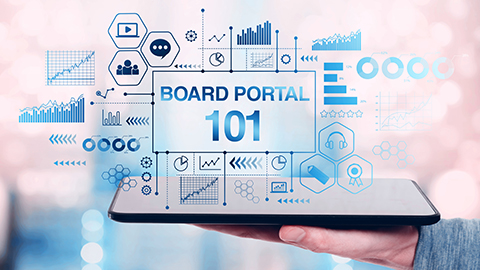Pension funds face the responsibility of creating effective policies for pensioners and safeguarding necessary pensioner data. With finance organizations needing to be swift while keeping confidentiality intact, how can pension boards transform their board processes to be more efficient?

Why Pension Boards Must Go Digital
The Need for Efficient and Paperless Processes
Common issues, like the tedious board pack preparation and absences in board meetings, render pension boards unproductive, considering the high-stakes nature of pension funds. Pension fund boards are expected to promote good governance by continuously assessing their workflows to manage confidential information and develop regulations for businesses.
One of the biggest challenges of pension boards is adapting to the fast-changing financial landscape that complicates pension fund management. Gone are the days that pension boards are filing and retrieving their records manually, which are tasks that are laborious and consume a lot of paper. This calls for efficient and paperless processes that will expedite the board workflows — making board meeting preparation and other workflows streamlined and paperless.
The Need for a Secure Document Archive
Vital documents, such as board and investment policies, must be kept secure and confidential at all times. Old and new policies should be readily available and easily accessed by the board whenever they need to. Additionally, confidential investment strategies and financial statements must be safeguarded at all times. The old-school filing cabinets and online drives may not be sufficient to provide security to all the sensitive information pension fund boards are handling. This intensifies the need for a secure repository that grants access only to those authorized board members.
How to Digitalize the Pension Board
The digitalization of pension board meetings and workflows addresses inefficiencies, leading to more effective communication and seamless collaboration among pension board members. Pension boards may be unique in purpose, but they still follow an organizational structure similar to other financial companies. Having the convenience of readily available workflows and templates and the ability to convene anytime and anywhere through virtual and hybrid meetings, help pension boards to efficiently collaborate and conclude their meetings faster.
One of the first steps to digital transformation for pension funds is adopting a digital tool that is intuitive and secure. A board portal is a digital solution that streamlines pension board workflows from board assessments and performance evaluations to review and approval of investment strategies and annual financial reports. It is designed to transform pension boards to be more collaborative and efficient for informed decision-making and better board governance.

The Board Portal Solution for Pension Boards
Streamlining Workflows
Board portals are equipped with easy-to-use and comprehensive compliance tools to simplify pension board processes. This allows board members to collaborate in real-time with each other, make private annotations, and share comments with other board members on records and policies. Such practices allow the pension board to make better and informed investment decisions anytime and anywhere.
Having a board portal will be able to boost the productivity of pension boards. Another capability of a board portal is pre-set workflows and templates. It can generate voting results and summary on certain policies or export the meeting minutes for record-keeping and tracking of action items.
Beyond board meetings, a board portal can aid in streamlining approval workflows by providing spaces to review and annotate documents, vote on resolutions, and electronically sign documents. This enables the board to easily and conveniently record votes for resolutions during meetings and initiate document approvals for the board through the board portal’s review rooms.
The digital signature feature of board portals helps pension boards achieve efficient, effective, and secure document approvals. A board portal’s complete suite of digital signature tools allows boards to affix their signatures instantly on documents, achieving faster turnarounds. It benefits the pension boards’ workflows by being cost-efficient, secure, and sustainable.
Board Governance
A board portal builds board members’ trust and confidence by promoting transparency and accountability through monitoring and tracking of actions. Having full control of the board through periodic evaluation of board performance in compliance with pension regulations is essential to pension funds. For instance, one can assign and set deadlines to action items arising from periodic board meetings. Not only that, but the board portal also allows users to notify board members of action items through email. This empowers the board members to monitor activities within the application, promoting a culture of transparency and accountability.
Document Management
Having secure storage for board policies, investment policies, and strategies is vital for pension funds. The financial security of pension funds relies on these documents, thus cunning as the target for cyberattacks.
Ideally, pension fund’s confidential policies must be kept secured in an electronic file system. A document repository allows pension boards to remotely review old and new investment policies anytime, anywhere granted that they are authorized to access the documents.
The distribution of pension fund documents must also be fast and secure. Managing pension funds is complex and critical, and the pension board should be prompt in disseminating information. A paperless meeting solution accelerates document distribution by sending meeting materials to all board members and directors and allowing them to review files with a single tap or click.
Security
Managing pension funds can get hectic, especially when dealing with security governance. GDPR-compliant data processing procedures, business continuity measures, incident detection mechanisms, vulnerability management procedures, and personnel security are some of the governance practices the pension board has to continuously comply with. The board portal’s robust security features offer users high levels of data protection, access control, availability, and application security so the pension board can focus on things that truly matter.
Board portals often have a multi-layered approach, mainly focusing on application security, cloud infrastructure, and network security. A board portal ensures suspicious activities made by intruders and hackers are tracked and prohibited from accessing any document or meeting. Advanced security features, like intrusion detection and prevention systems and user authentication, ensure that meeting processes are secure from any threats. Additionally, the board portal’s application security grants its users full system ownership — from managing user roles and devices to setting system and security preferences to prevent unwanted access.

Achieve Better Pension Board Governance with a Board Portal
Pension boards must go digital to keep up with the demands of the fast-changing financial landscape. The paperless process with a board portal streamlines the workflow of pension boards, addressing inefficiency and tiresome workload issues in the boardroom. Powerful features of a board portal such as document management, collaborative tools, and security measures simplify the pension boards’ work — boosting their productivity.
Guided by a strong insight into the governance needs of pension funds, and with the support of a highly-trained development team, Convene promotes board governance through its smart features and functions that are designed to keep your pension fund board in check. Find out more about the features of a board portal solution to help with streamlining the workflows of pension boards.
Darren is the Content Director at Convene. Driven by his passion for content writing and knowledge of digitalization, he takes pride in providing content that helps drive digital transformation. Over the years, he has written blogs related to digital meetings, board management, and modern governance.










